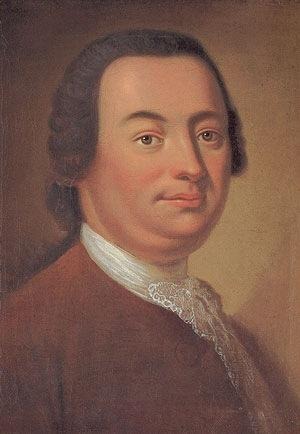Johann Christoph Friedrich Bach facts for kids
Quick facts for kids
Johann Christoph Friedrich Bach
|
|
|---|---|

Portrait of Bach, by Georg David Matthieu, 1774
|
|
| Born | 21 June 1732 |
| Died | 26 January 1795 (aged 62) Bückeburg
|
| Occupation |
|
Johann Christoph Friedrich Bach (born June 21, 1732, died January 26, 1795) was a German composer and a master of the harpsichord. He was the fifth son of the famous composer Johann Sebastian Bach. People sometimes called him the "Bückeburg Bach" because of where he lived and worked for most of his life.
Contents
Early Life and Musical Start
Johann Christoph Friedrich Bach was born in Leipzig, Germany. His father, Johann Sebastian Bach, was his first music teacher. He also learned from a distant cousin, Johann Elias Bach.
He went to the St. Thomas School in Leipzig. Some people think he might have studied law at the university there, but there are no official records to confirm this.
In 1750, when he was just 18, a ruler named William, Count of Schaumburg-Lippe hired him. Johann Christoph became the harpsichordist at Bückeburg. This was a very important job. By 1759, he was promoted to concertmaster, which meant he was the main musician leading the orchestra.
While in Bückeburg, Bach worked with a writer named Johann Gottfried Herder. Herder wrote words for six of Bach's vocal music pieces. Today, we only have the music for four of these.
His Music Style
Bach wrote many different kinds of music. He composed pieces for the keyboard called sonatas. He also wrote symphonies for orchestras. For singers, he created oratorios, which are like big stories told with music. He also wrote church music, such as choir pieces and motets. He even composed operas and songs.
The Count he worked for, Wilhelm, really liked Italian music. So, Bach had to change his style to fit this taste. But he still kept some of the musical ideas from his father and his brother, C. P. E. Bach.
Family Life
In 1755, Johann Christoph Friedrich Bach married a singer named Lucia Elisabeth Münchhausen. They had a son named Wilhelm Friedrich Ernst Bach. The Count himself was the godfather to their son.
Just like his own father taught him, J. C. F. Bach taught his son music. Wilhelm Friedrich Ernst grew up to be a music director for Frederick William II of Prussia, a very important king.
In April 1778, Johann Christoph Friedrich Bach and his son Wilhelm traveled to England. They went to visit his brother, Johann Christian Bach, who also lived there. J. C. F. Bach passed away in Bückeburg in 1795. He was 62 years old.
His Legacy
Johann Christoph Friedrich Bach was a very busy composer. The 1911 Encyclopædia Britannica said that his work honored his family's name. He was an amazing keyboard player. Many of his works still exist today. These include twenty symphonies. His later symphonies were influenced by famous composers like Joseph Haydn and Wolfgang Amadeus Mozart. He wrote almost every type of vocal music.
Sadly, a large part of J. C. F. Bach's music was lost. This happened during World War II when the Staatliches Institut für Musikforschung in Berlin was destroyed. His original music scores had been stored there since 1917.
Music experts like Hansdieter Wohlfahrth and Ulrich Leisinger see Bach as a "transitional" composer. This means his music helped bridge different styles. Some of his pieces sound like the older Baroque style. Others sound like the lighter galant style. And some even combine these with the newer classical style that was just starting.
Selected Works
Johann Christoph Friedrich Bach wrote many pieces. Here are some examples of his music.
Keyboard Music
- Keyboard Sonatas: He wrote many sonatas for keyboard instruments like the harpsichord or pianoforte. Some were easy for students, while others were more complex.
- Variations: He composed variations on popular tunes. One famous example is "Allegretto in G major with 18 Variations on 'Ah vous dirais-je Maman'". This is the same tune used for "Twinkle, Twinkle, Little Star".
- Pieces for four hands: He also wrote sonatas for two people to play on one keyboard.
Chamber Music
Chamber music is for a small group of instruments.
- Cello Solos: Pieces for a single cello.
- Trios: Music for three instruments, like a flute, violin, and another instrument.
- Sonatas for Keyboard and Flute (or Violin): These were very popular. He published six of these in 1777.
- Quartets: Music for four instruments. He wrote six quartets for flute, violin, viola, and basso continuo. He also wrote six string quartets for two violins, viola, and basso continuo when he was in England.
Orchestral Music
Orchestral music is for a large group of instruments.
- Symphonies: He wrote many symphonies. Some were for smaller orchestras, and later ones were for larger groups.
- Keyboard Concertos: These are pieces where a solo keyboard instrument plays with an orchestra. He wrote several of these, including six "London Concertos" after his trip to England.
Vocal Music
- Oratorios: These are large musical works, often telling religious stories. Some of his well-known oratorios include Der Tod Jesu (The Death of Jesus) and Die Kindheit Jesu (The Childhood of Jesus).
- Cantatas: These are shorter vocal works, often for church services.
- Arias and Songs: He wrote many individual songs and arias (songs for a solo singer).
Images for kids
See also
 In Spanish: Johann Christoph Friedrich Bach para niños
In Spanish: Johann Christoph Friedrich Bach para niños


